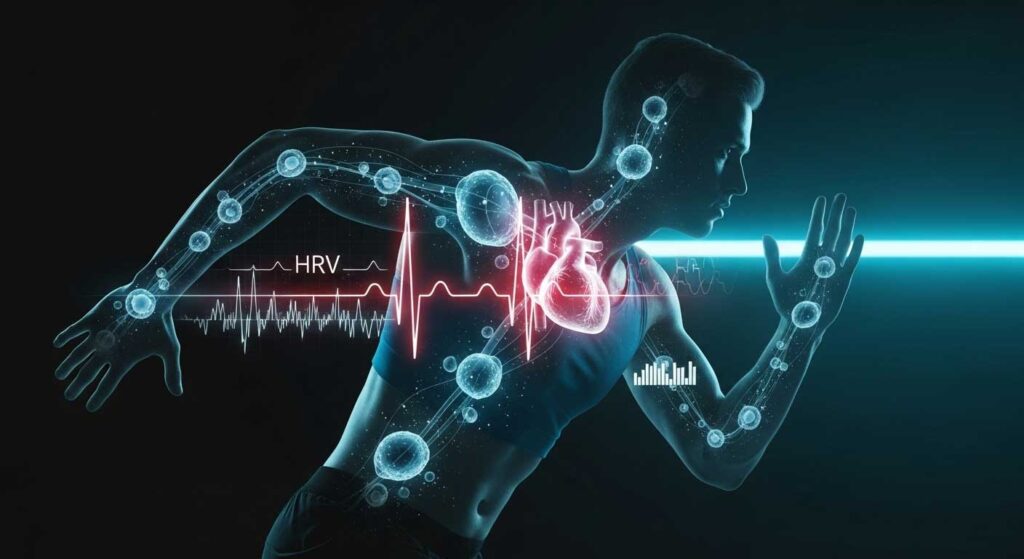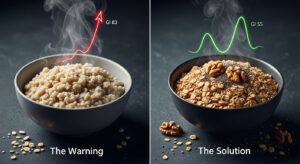For anyone committed to an active lifestyle, there’s an unspoken conversation that happens with your body every day. You know the feeling of a strong, fluid run, the satisfying burn of a heavy lift, and the precise amount of rest you need to bounce back. But what happens on the days when that conversation feels… off? A familiar workout suddenly feels draining, your heart races for no reason, or your recovery takes days longer than usual. It’s easy to dismiss these moments as just a “bad day.”
- Your Body's Built-in Warning System: The Performance Baseline
- The Power of Data: Key Physiological Metrics to Monitor
- The Tech Revolution: How Wearable Health Devices Aid in Early Detection
- Common Culprits: Diseases Unmasked by Performance Declines
- Overtraining vs. Illness: How to Tell the Difference
- Proactive Health: Integrating Fitness with Medical Care
- Conclusion
- Frequently Asked Questions (FAQ)
But what if they’re something more? Your body’s performance is not just a reflection of your training; it’s a high-sensitivity barometer for your overall health. Unexplained changes in your fitness & athletic performance are often the first, most subtle signs that something is wrong internally. This article is your guide to understanding these signals. By learning to listen to your body and leveraging the powerful data from today’s wearable health devices, you can shift from a reactive to a proactive stance on your health, enabling the early detection of diseases long before they become serious.

Your Body’s Built-in Warning System: The Performance Baseline
The foundation of using fitness & athletic performance for health monitoring lies in one simple concept: the baseline. Consistent training creates a highly predictable pattern of how your body performs and recovers. Any significant, unexplained deviation from this baseline is a signal that warrants your full attention. It’s one of the primary ways how exercise reveals hidden medical conditions.
Sudden Drop in Stamina and Strength
A sudden drop in athletic performance is perhaps the most obvious red flag. This isn’t about failing to hit a new personal record; it’s about struggling with what was once your routine. For example, if you’re a runner who could comfortably handle five miles and now you feel winded after two, that’s a significant change. Similarly, if your usual warm-up weight at the gym suddenly feels heavy and challenging, your body is sending a message. When this persists for more than a few days, it’s a sign that your body’s energy systems are being compromised by an unseen stressor.
Disproportionate Fatigue During Workouts
There’s a massive difference between the satisfying tiredness after a great workout and the deep, systemic exhaustion that can signal an underlying problem. A key sign of a fatigue during workouts underlying condition is what experts call “disproportionate fatigue”—an overwhelming sense of tiredness that is completely out of proportion to the effort you’ve exerted. This can feel like “hitting a wall” or “bonking” on a workout that should have been well within your capabilities. It suggests your body is struggling to produce or utilize energy effectively at a cellular level.
Slower-Than-Normal Recovery
Your ability to recover is a direct measure of your body’s health and resilience. When you are healthy, your body efficiently repairs muscle tissue, replenishes energy stores, and reduces inflammation. If you notice that your typical 48-hour recovery period has stretched to 72 or 96 hours, or that deep muscle soreness (DOMS) lingers for days longer than usual, it’s a sign that your body is diverting its precious resources. Instead of focusing on recovery from exercise, it may be busy fighting off an infection, managing systemic inflammation, or dealing with a metabolic issue.

The Power of Data: Key Physiological Metrics to Monitor
While listening to your body is crucial, modern technology allows us to quantify these feelings with objective data. The rise of wearable health devices has given us unprecedented access to the inner workings of our physiology, turning subjective feelings into actionable insights for the early detection of diseases.
Resting Heart Rate (RHR): The Classic Indicator
Your RHR is the number of times your heart beats per minute when you are at complete rest. For a fit individual, a lower RHR (often in the 40s or 50s) is a sign of a strong, efficient cardiovascular system. More importantly, your RHR should be stable. This metric is a powerful resting heart rate disease indicator. A sustained, unexplained increase of 7-10 beats per minute over several days is a significant signal that your body is under stress. This is often the very first sign your immune system is ramping up to fight an infection, sometimes days before you feel a single symptom. It can also indicate dehydration, poor sleep, or more chronic issues like thyroid problems.

Heart Rate Variability (HRV): Your Body’s Stress Gauge
Heart Rate Variability (HRV) is a sophisticated metric that measures the tiny variations in time between each of your heartbeats. It is controlled by your autonomic nervous system (ANS), which has two branches: the “fight-or-flight” system and the “rest-and-digest” system.
Understanding Heart Rate Variability (HRV) health is simple:
- A high HRV is a sign that your “rest-and-digest” system is in control. Your body is well-recovered, resilient, and ready to handle stress.
- A low HRV indicates that your “fight-or-flight” system is dominant. Your body is under stress, whether from overtraining, poor sleep, mental anxiety, or an impending illness.
Many athletes and users of wearable health devices report seeing a sharp decline in their HRV score 1-2 days before they consciously feel the symptoms of a cold, flu, or other infection, making it a powerful tool for the early detection of diseases.
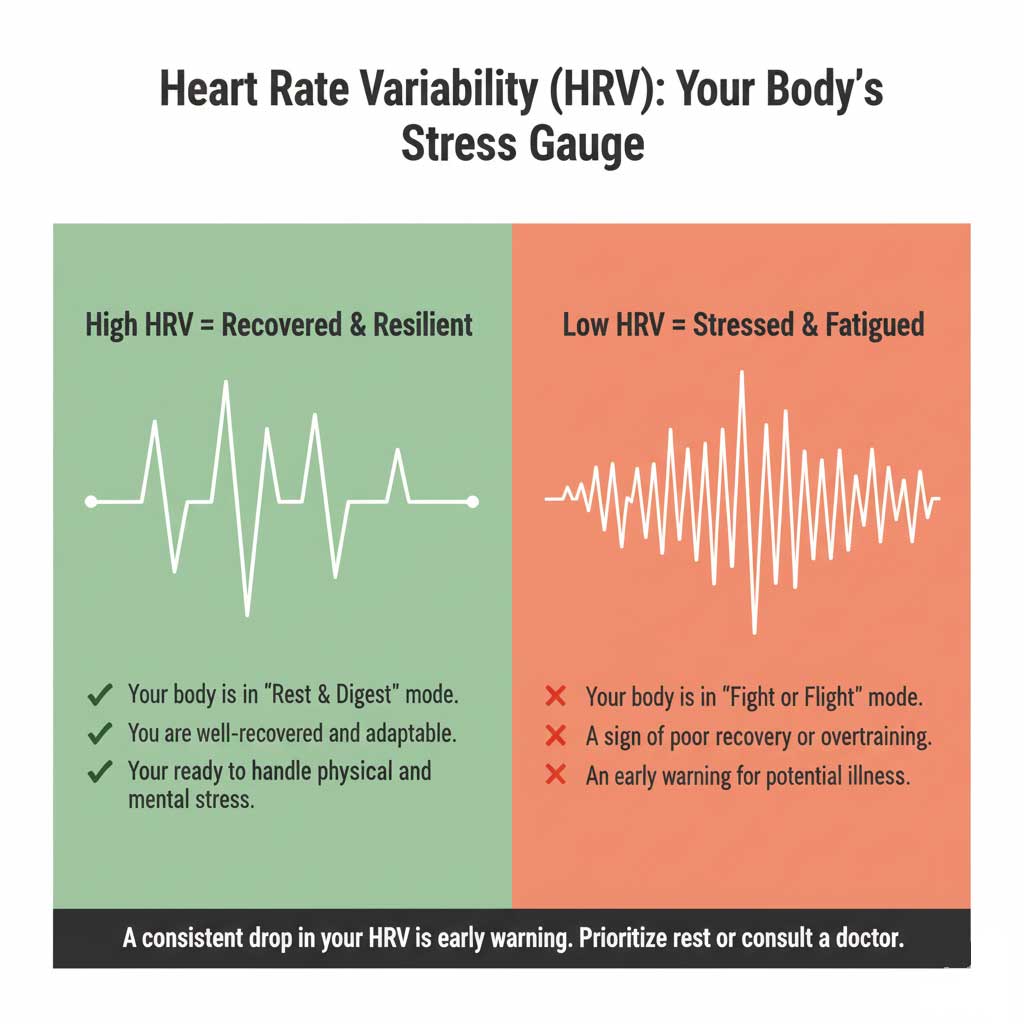
Respiratory Rate and Blood Oxygen (SpO₂)
Two other metrics gaining prominence are respiratory rate (breaths per minute) and blood oxygen saturation (SpO₂). An elevated respiratory rate while at rest can be an early indicator of a developing fever or respiratory illness. Similarly, while SpO₂ monitoring is not a diagnostic tool for daytime issues, consistently low readings during sleep can be a sign of conditions like sleep apnea, which severely disrupts recovery and places significant stress on the cardiovascular system.
The Tech Revolution: How Wearable Health Devices Aid in Early Detection
What started as simple pedometers have evolved into sophisticated health screening tools worn on our wrists. The ability of wearable health devices to continuously monitor our physiology is revolutionizing personalized health and the early detection of diseases.
A Proven Success Story: Atrial Fibrillation Detection
Perhaps the most powerful example of this technology in action is its ability to detect atrial fibrillation (AFib), a common and potentially serious type of irregular heartbeat that can lead to stroke. Many modern smartwatches are now equipped with ECG (electrocardiogram) sensors and irregular rhythm notification features.
The credibility of this technology was firmly established by the landmark Apple Heart Study. This massive study, involving over 400,000 participants, demonstrated that the Apple Watch could accurately identify AFib in 84% of users who received a notification and followed up with clinical-grade monitoring. This is a powerful real-world instance of Apple watch atrial fibrillation detection. For the U.S. audience, it’s critical to note that these features have received FDA-clearance, signifying they have met stringent standards for accuracy and reliability as non-diagnostic screening tools.
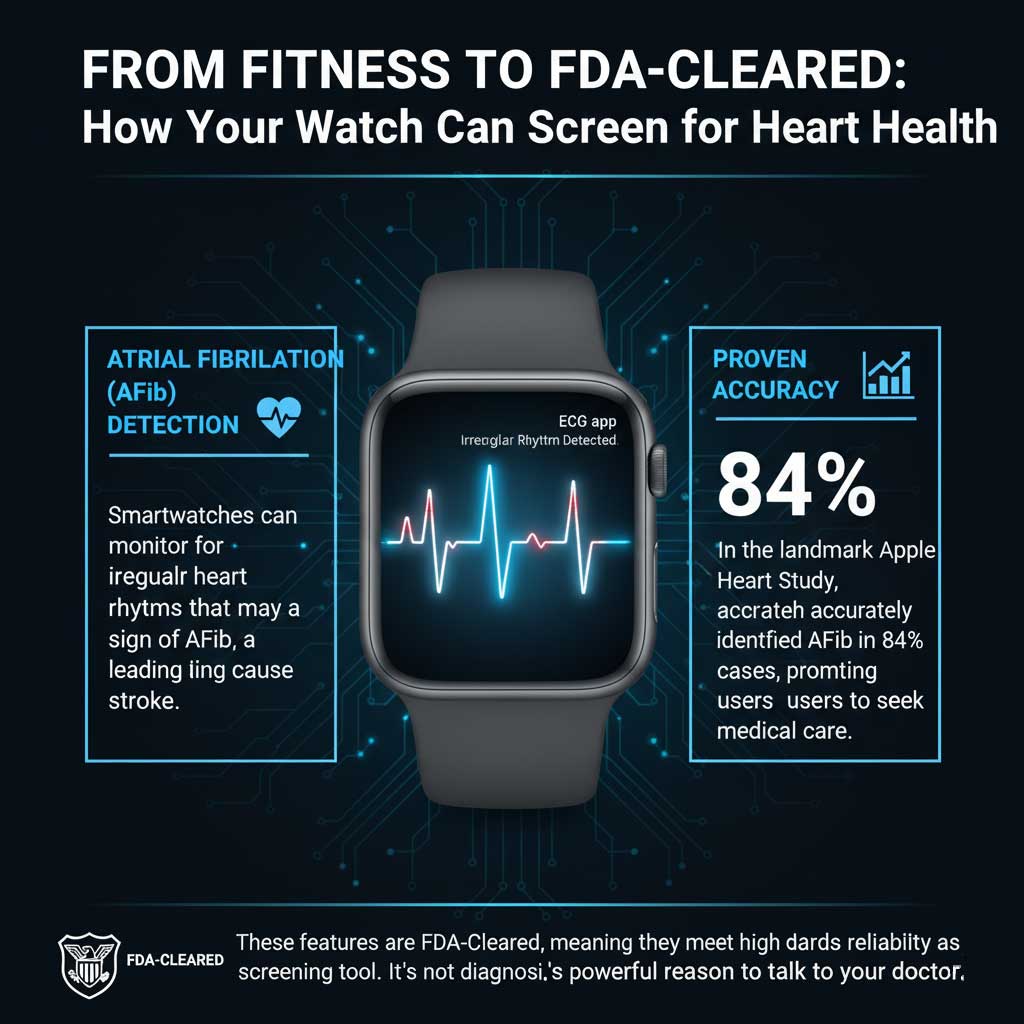
The Future: AI and Predictive Analytics
The next frontier is the use of artificial intelligence to analyze your long-term health data. Algorithms can now identify subtle patterns and deviations in your metrics that are invisible to the human eye. Researchers have already demonstrated that AI models can predict the onset of infections like COVID-19 and influenza by analyzing changes in RHR, HRV, and skin temperature several days before a person reports feeling sick. This predictive power is transforming wearable health devices from passive trackers into proactive health guardians.
Common Culprits: Diseases Unmasked by Performance Declines
When your fitness & athletic performance takes a nosedive, it’s often a sign of a handful of common, treatable conditions. Recognizing these patterns can help you and your doctor pinpoint the problem quickly.
Iron-Deficiency Anemia
This is one of the most common causes of unexplained fatigue and poor performance, especially in female athletes. Iron is a critical component of hemoglobin, the protein in red blood cells that transports oxygen to your muscles. When iron levels are low, your oxygen-carrying capacity plummets. Anemia symptoms in athletes include:
- Disproportionate fatigue and shortness of breath during exercise.
- A feeling of “heavy” legs.
- Reduced power output.
- Pale skin and brittle nails.
Thyroid Disorders
The thyroid gland acts as the master regulator of your metabolism. When it’s not functioning correctly, the impact on your energy and performance is profound.
- Hypothyroidism and exercise intolerance are closely linked. An underactive thyroid (hypothyroidism) slows down your entire metabolism, leading to persistent fatigue, muscle weakness, unexplained weight gain, and poor recovery.
- Hyperthyroidism (an overactive thyroid) can cause a persistently high resting heart rate, anxiety, tremors, and a feeling of being “burnt out,” as your body is stuck in a state of overdrive.
Diabetes and Insulin Resistance
If your body cannot effectively manage blood sugar, your muscles are starved of their primary fuel source: glucose. This can lead to a fatigue during workouts underlying condition. Athletes with undiagnosed insulin resistance or diabetes may experience sudden and dramatic energy crashes, feeling like they’ve “hit the wall” or “bonked” during workouts that should be manageable.
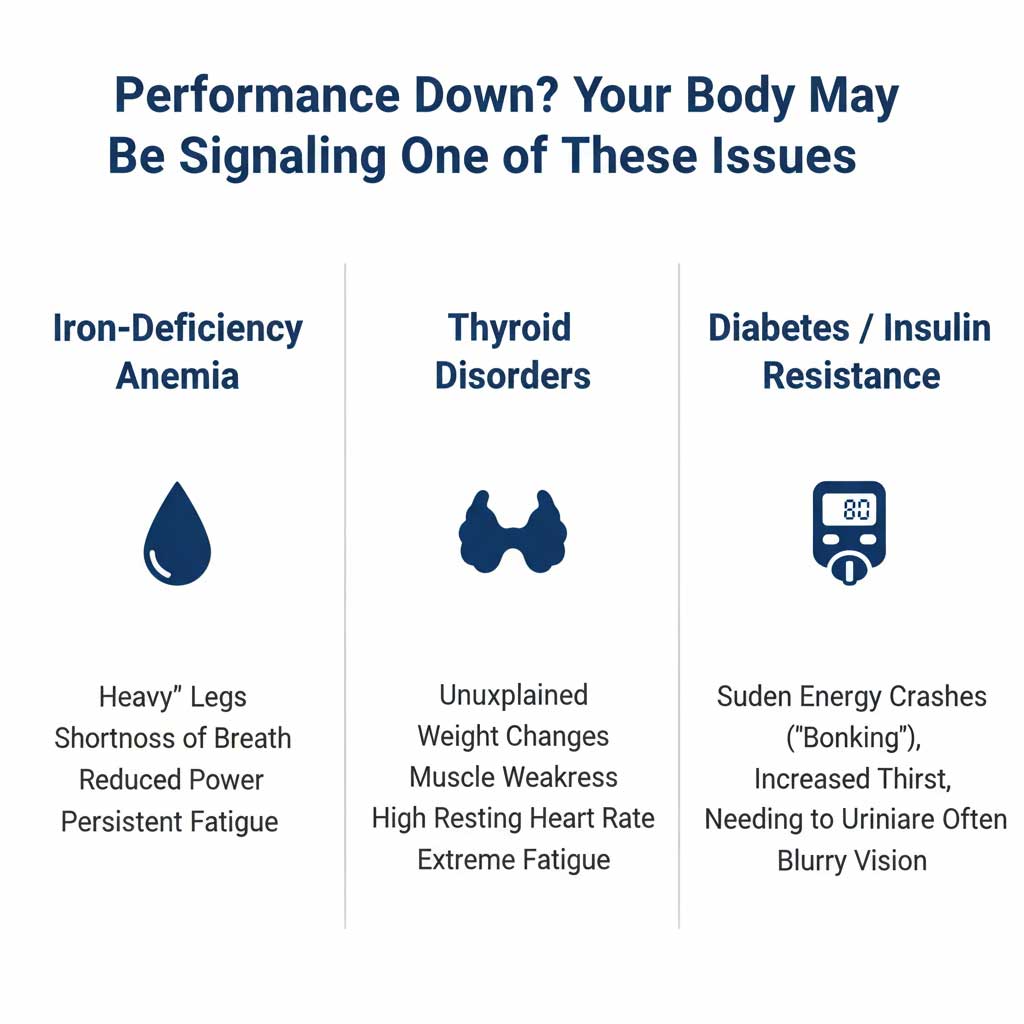
Taking Control with Proactive Testing
If these symptoms sound familiar, a simple blood test can provide definitive answers. Waiting for a doctor’s appointment can be time-consuming, but services like HealthCareOnTime.com allow you to take control. You can order crucial tests like the ‘Complete Anemia Panel’ or a ‘Comprehensive Thyroid Test’ online. A professional collects your sample at home, and the results from a certified lab can quickly identify the root cause of your performance decline, allowing you to seek treatment faster.

Overtraining vs. Illness: How to Tell the Difference
For any dedicated athlete, the most pressing question is often: “Am I sick, or am I just overtrained?” The overtraining vs illness symptoms overlap significantly, causing confusion and frustration. Both can cause fatigue, a high RHR, poor performance, and mood disturbances. However, there is a critical way to distinguish between the two.
The ultimate litmus test is your body’s response to a dedicated period of rest. Symptoms of overtraining will begin to improve with a structured deload week or a few days of complete rest. Symptoms of an underlying medical condition will persist or even get worse, despite the reduction in training load.

| Feature | Overtraining Syndrome (OTS) | Underlying Medical Illness |
| Onset | Gradual, following a period of increased training load or insufficient recovery. | Can be gradual or sudden, often unrelated to training changes. |
| Key Symptoms | Persistent muscle soreness, heavy/lethargic limbs, decreased motivation, moodiness, sleep disturbances. | Systemic fatigue (“bone-tired”), weakness, fever, chills, unusual pain, swollen lymph nodes, symptoms unrelated to exercise. |
| Heart Rate Response | Resting heart rate is often elevated. Heart rate may be slow to decrease after exercise. | Resting heart rate is consistently elevated. May also experience palpitations or irregular rhythms. |
| Effect of Rest | Symptoms improve significantly with 1-2 weeks of active recovery or complete rest. | Symptoms persist or worsen despite adequate rest. Rest provides little to no relief. |
| Next Step | Implement a structured deload week, prioritize sleep and nutrition, and gradually return to training. | Consult a healthcare professional. Do not try to “train through it.” Further testing is required. |
Proactive Health: Integrating Fitness with Medical Care
Your personal fitness journey and your clinical healthcare should not exist in separate silos. By integrating your performance data with regular medical checkups, you create a holistic and powerful approach to your long-term health.
VO₂ Max: A Key Predictor of Longevity
Your VO₂ max and heart health are inextricably linked. VO₂ max, the maximum amount of oxygen your body can utilize during exercise, is considered by many cardiologists to be the single best predictor of cardiovascular health and all-cause mortality. Research consistently shows that a higher VO₂ max is associated with a longer, healthier life. A decline in your aerobic capacity can be an early sign that your heart’s pumping efficiency is decreasing, highlighting how a person’s fitness level and longevity are connected.

The Role of Exercise Stress Tests
Formal exercise stress tests are a clear example of how fitness tests detect heart problems. In a controlled medical setting, an ECG monitors your heart’s electrical activity while you walk on a treadmill. This can reveal underlying coronary artery disease or arrhythmias that might not be apparent at rest.
Sharing Your Data with Your Doctor
Don’t hesitate to share your performance and wearable data with your doctor. It provides them with invaluable context that they can’t get from a 15-minute office visit. Showing your doctor a chart from your watch that illustrates your resting heart rate disease indicator trend—a steady climb over three weeks—is objective evidence that can prompt them to order the right tests immediately.

To get an even more complete picture, you can complement your performance data with regular biomarker analysis. Services like the ‘Athlete’s Health & Performance Panel’ from HealthCareOnTime.com provide a comprehensive look at your blood count, electrolytes, liver and kidney function, and key vitamin levels. This gives you and your doctor a 360-degree view of your health, combining external performance with internal biochemistry.

Conclusion
Your fitness & athletic performance is far more than a hobby or a measure of your physical prowess; it is a dynamic, real-time indicator of your health. By learning to listen to your body’s signals, tracking key physiological metrics with wearable health devices, and recognizing when your performance data is telling you something is wrong, you can become the first line of defense in your own healthcare.

This knowledge is not a source of anxiety, but a tool of empowerment. It allows you to catch potential problems early, engage with your doctor more effectively, and take proactive control of your long-term well-being.

